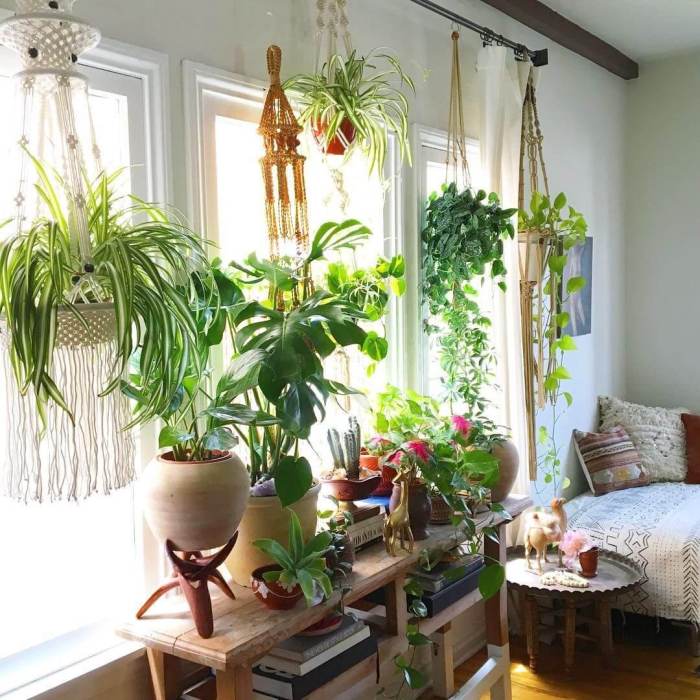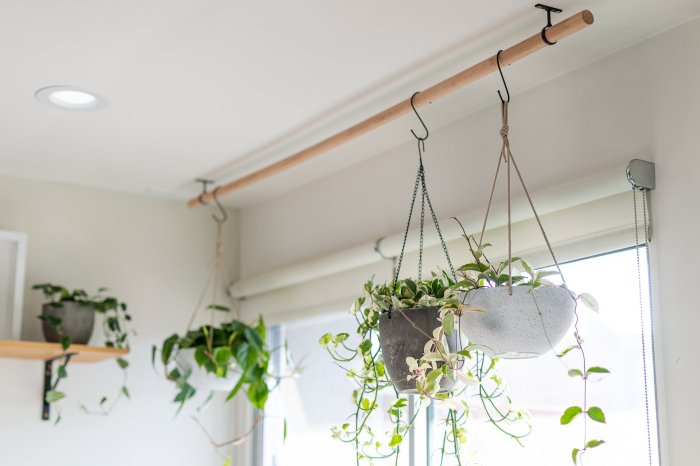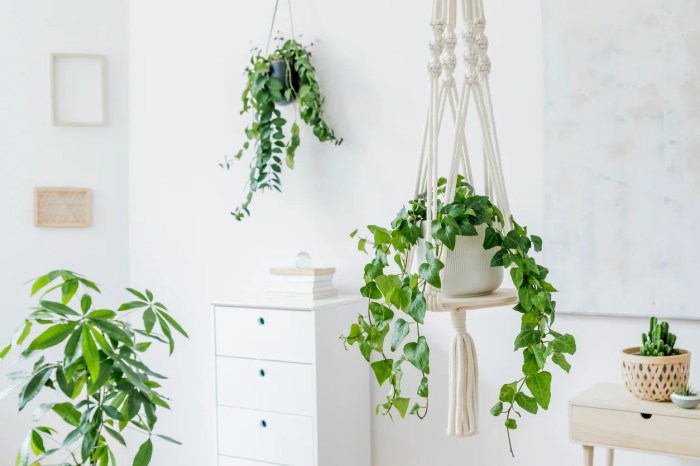In the realm of interior and exterior design, where to hang hanging plants emerges as a topic of utmost importance. This comprehensive guide delves into the intricacies of selecting the ideal locations for your verdant companions, ensuring their flourishing and aesthetic appeal.
Whether you seek to create an indoor oasis or enhance your outdoor space with a touch of greenery, this discourse provides invaluable insights into the factors that influence the placement of hanging plants. From lighting and humidity to sunlight and wind, we explore the nuances that will empower you to make informed decisions, fostering the well-being of your beloved plants.
Indoor Placement Considerations

Indoor placement is crucial for the health and well-being of hanging plants. Understanding their lighting, humidity, and airflow requirements ensures optimal growth and prevents potential issues.
Lighting
Most hanging plants prefer bright, indirect light. Avoid placing them in direct sunlight, as this can scorch their leaves. East- or west-facing windows are ideal, providing ample light without excessive heat. Consider using sheer curtains or blinds to filter sunlight if necessary.
Popular Indoor Hanging Plants and Their Light Requirements
- Spider plant:Prefers bright, indirect light but can tolerate low light conditions.
- Pothos:Thrives in low to bright, indirect light.
- Snake plant:Tolerates low light but prefers bright, indirect light.
- ZZ plant:Known for its exceptional tolerance to low light conditions.
Humidity and Airflow
Many hanging plants prefer high humidity levels. Misting them regularly or using a humidifier can provide the necessary moisture. Additionally, ensuring good airflow around the plants prevents moisture buildup and promotes healthy growth.
Outdoor Placement Strategies

When selecting outdoor locations for hanging plants, consider sunlight, wind, and temperature. Choose areas with ample bright, indirect light, as most hanging plants prefer filtered shade. Avoid direct sunlight, which can scorch leaves. Protect plants from strong winds, which can damage foliage and uproot containers.
Ensure temperatures remain within the plant’s hardiness range, as extreme heat or cold can stress or kill plants.
Creating Visually Appealing Displays
Arrange hanging plants at varying heights to create depth and interest. Suspend plants from trees, pergolas, or walls, ensuring they receive adequate light and air circulation. Combine different plant species with contrasting colors, textures, and shapes for a visually striking display.
Consider using macrame hangers, decorative baskets, or ornate hooks to add a touch of style. Experiment with vertical gardening by suspending multiple plants vertically, creating a lush, cascading effect.
Hanging Plant Design and Aesthetics
Hanging plants add a touch of greenery and style to any space, but the way you hang them can make a big difference in the overall look and feel. Here are a few tips for hanging plants in a way that complements your décor and showcases your plants to their best advantage.
When searching for the perfect place to hang hanging plants, consider areas with ample sunlight and adequate space for growth. For those seeking stylish and durable hanging plant baskets, bunnings hanging plant baskets offer a wide selection to complement any home décor.
Continue exploring various hanging locations, such as porches, patios, or even indoors near windows, to find the ideal spot for your hanging plants.
Hanging Methods
There are a variety of ways to hang plants, from simple hooks to elaborate macrame hangers. The best way to hang a plant depends on the size and weight of the plant, as well as the style of your décor.
Hanging plants are a great way to add some greenery to your home, but they can be a bit tricky to water. If you’re looking for a convenient way to water your hanging plants, you might want to consider using a hanging plant watering bottle bunnings . These bottles are designed to make watering your plants easy and mess-free.
They come with a long spout that makes it easy to reach the roots of your plants, and they have a built-in reservoir that holds water so you don’t have to refill them every time you water your plants. If you’re looking for a way to make watering your hanging plants easier, a hanging plant watering bottle is a great option.
- Macrame hangersare a popular choice for hanging plants because they add a touch of bohemian style. Macrame hangers are available in a variety of sizes and colors, so you can find one that fits your plant and your décor.
- Chainsare another option for hanging plants. Chains are strong and durable, and they can be used to create a variety of looks, from industrial to elegant.
- Basketsare a great way to add a touch of rustic charm to your hanging plants. Baskets are available in a variety of materials, including wicker, metal, and plastic.
Choosing the Right Container
The container you choose for your hanging plant is just as important as the way you hang it. The container should be large enough to accommodate the plant’s roots, but it should not be so large that it overwhelms the plant.
Hanging plants can add a touch of greenery to any room, but where should you hang them? One option is to use a wall planter. Wall planters are available in a variety of styles and sizes, so you can find one that fits your décor and the size of your plant.
Bunnings has a wide selection of wall planters to choose from, including wall planter bunnings . No matter where you choose to hang your hanging plants, they are sure to add a touch of beauty to your home.
The container should also be made of a material that is durable and weather-resistant if you plan to hang it outdoors.
Creating Unique Arrangements
Once you have chosen a hanging method and a container, you can start to create a unique and stylish hanging plant arrangement. Here are a few ideas:
- Hang plants at different heights.This will create a more dynamic look and make it easier to water your plants.
- Group plants together in odd numbers.This will create a more visually appealing arrangement.
- Use a variety of plants.This will add interest and texture to your arrangement.
Plant Care and Maintenance

Hanging plants add a touch of greenery and elegance to any space. However, to keep them thriving, specific care and maintenance are necessary. Here’s a comprehensive guide to watering, fertilizing, pruning, and managing pests and diseases for your hanging plants.
Watering
Watering hanging plants can be tricky, as the soil dries out faster than in traditional pots. Allow the top 1-2 inches of soil to dry out before watering thoroughly. Water until the excess drains out the drainage holes. Avoid overwatering, as it can lead to root rot.
Fertilizing
Hanging plants benefit from regular fertilizing. Use a balanced liquid fertilizer diluted to half strength every 2-4 weeks during the growing season. Avoid over-fertilizing, as it can burn the roots.
Pruning
Regular pruning is essential for maintaining the shape and health of hanging plants. Remove dead or damaged leaves and stems promptly. Pinch back trailing stems to encourage bushier growth. Prune heavily in spring to promote new growth.
Pest and Disease Management
Hanging plants can be susceptible to common pests and diseases. Inspect plants regularly for signs of infestation or infection. Use insecticidal soap or neem oil to treat pests. For diseases, isolate affected plants and treat with appropriate fungicides.
Repotting
Hanging plants may need to be repotted as they grow. Choose a pot with adequate drainage holes and a size that is slightly larger than the current pot. Use a well-draining potting mix and gently transfer the plant, ensuring the roots are not disturbed.
Inspiration and Examples

Hanging plants add a touch of nature and tranquility to any space. They can be used to create a vertical garden, add privacy, or simply brighten up a room. There are endless possibilities when it comes to hanging plants, and the following examples will provide you with some inspiration for your own home or office.
Hanging plants can be used in a variety of settings, from homes to offices to gardens. They are a great way to add a touch of greenery to any space, and they can also help to improve air quality.
Gallery of Visually Stunning Hanging Plant Installations
- A living wall of hanging plants can create a stunning focal point in any room.
- Hanging plants can be used to create a privacy screen or to divide a space.
- A few hanging plants can add a touch of color and life to a small space.
Examples of Hanging Plants Used in Various Settings
- In a home, hanging plants can be used to decorate a living room, bedroom, or kitchen.
- In an office, hanging plants can help to create a more relaxing and productive environment.
- In a garden, hanging plants can be used to add height and interest to a landscape.
Resources for Purchasing Hanging Plants and Accessories, Where to hang hanging plants
- Local nurseries and garden centers are a great place to find hanging plants and accessories.
- Online retailers also offer a wide variety of hanging plants and accessories.
- Some home improvement stores also sell hanging plants and accessories.
Closing Summary
In conclusion, the placement of hanging plants is an art form that requires careful consideration of various factors. By understanding the specific needs of your plants and the environmental conditions of your space, you can create visually stunning displays that bring life and vitality to your surroundings.
Embrace the joy of hanging plants, and let their verdant beauty transform your living spaces into havens of tranquility and aesthetic delight.
User Queries: Where To Hang Hanging Plants
What are the ideal lighting conditions for indoor hanging plants?
Most indoor hanging plants thrive in bright, indirect light. Avoid placing them in direct sunlight, as this can scorch their leaves.
What are some popular indoor hanging plants and their specific light requirements?
Some popular indoor hanging plants include pothos, spider plants, and philodendrons. Pothos and spider plants can tolerate low light conditions, while philodendrons prefer bright, indirect light.
How do I choose a hanging plant container that complements the plant and the surrounding décor?
Consider the size, shape, and material of the container. Choose a container that is large enough to accommodate the plant’s root system and that complements the style of your décor.